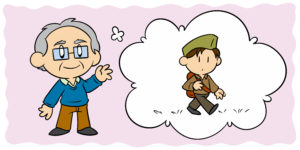It’s common knowledge that every story has already been told. From boy meets girl to boy eats girl, we’ve had thousands and thousands of years to express every possible variant of human experience and interaction. For many authors this is a worrying truth, suggesting that there’s no worth in creating anything new.
But is this true? In a word: no. Paring a story down to its basic plot allows unusual comparisons, and the internet has made a game of finding the most disparate examples possible. Whether it’s Christopher Daed’s comparison of Home Alone and Die Hard, CinemaSins’ ‘24 Reasons Matilda and Chronicle are the Same Movie’ or Reddit’s attempts to sum up two unrelated movies with the same sentence, examples both amazing and amazingly bad are available in abundance.
But a story is more than the basest interpretation of its plot. Anna Quindlen, author of One True Thing, Black and Blue and Still Life with Bread Crumbs, explains:
Once you’ve read Anna Karenina, Bleak House, The Sound and the Fury, To Kill a Mockingbird and A Wrinkle in Time, you understand that there is really no reason to ever write another novel. Except that each writer brings to the table, if she will let herself, something that no one else in the history of time has ever had.
– Anna Quindlen, Commencement speech at Mount Holyoke College
Perspective makes stories new again, showing that we don’t need a new series of events to get interested, just a new way of looking at them. For many authors that might be a comfort, but I’d argue that it can be more than that. Understanding this truth about writing can help you write incredible stories and understand why they work so well. That’s why in this article I’ll be arguing that a new understanding of basic plot lines can help you create something amazing.
Perspective and the monomyth
In The Hero with a Thousand Faces, author Joseph Campbell argues that the most enduring mythological stories follow the same structure. He represents this as a circle known as ‘The Hero’s Journey’, which includes the following points:
- The call to adventure
- Supernatural aid
- Passing through the threshold to the unknown
- The arrival of a helper or mentor
- Challenges and temptations
- Revelation, usually centering around death and rebirth
- Transformation
- Atonement
- Return to the known
This is a basic explanation of the monomyth, which draws a huge number of parallels between humankind’s varying mythologies. Campbell’s conclusion is that the similarities are no coincidence – every society creates some version of the monomyth because as a story it addresses some of the basic questions inherent to the human condition. The story is almost a necessity of human civilization, addressing urges so core to our psychology that we seem unable to resist creating it.
Most enduring mythological stories follow this same structureClick To TweetOf course every civilization adds their own spin, altering the aesthetic of the story to suit their time and culture. The monomyth has been used to explain stories as ancient as The Odyssey and as recent as Lord of the Rings and Jaws. The Wizard of Oz follows its beats, as do famous movies like Fight Club, The Karate Kid and Rain Man.
For all its generality, what the monomyth proves is that the repetition of story structures isn’t a problem, it’s just how stories work. We don’t need new approaches to redeem something stale, we need them as an invitation to re-engage with a narrative that allows us to explore deep and important aspects of the human condition.
That doesn’t mean that nothing’s new, it means that ‘new’ was never the point. The monomyth shows that there are stories we want to experience so strongly that we’ll write a thousand versions of them. For authors this is great news, since it means they already know exactly what kind of stories readers are desperate to get their hands on.
Everything old is new again
Of the many internet theories I mentioned above, the most compelling is the comparison between Shakespeare’s Hamlet and Disney’s The Lion King. Both stories tell the tale of a young prince whose father is killed by a jealous uncle keen to seize the throne. Simba and Hamlet both leave their homes and childhood loves, bound on a maturing trip with friends who are more interested in their childish sides. Eventually they return, slaying their murderous uncles at the ghostly behest of their fathers.
Disney’s version is more child-friendly – Nala the lion ends the movie unscathed, and the meerkat/warthog duo of Timon and Pumbaa have less to fear from The Lion King’s protagonist than the ill-fated Rosencrantz and Guildenstern – but swaps very few story beats in comparison with its seventeenth-century inspiration.
So what’s the conclusion? Are Disney frauds, stealing one of Shakespeare’s most famous plays and peddling it to an unsuspecting audience? Of course not; Disney merely identified a powerful story and made it their own.
To say that The Lion King is Hamlet is to misunderstand the substance of both stories. The Lion King adds humor, romance and music to Hamlet, and uses the story beats of a Shakespearian tragedy to create a comedy for children.
The Lion King uses the story beats of Hamlet to create a comedy for children.Click To TweetIn the same way, authors can use tried-and-tested story beats to create something that’s as ‘new’ as any story can be. More than that, they can use their appreciation for earlier versions of the story to write a hit. At their core, both Hamlet and The Lion King talk about maturity through the son’s duty to the father and willing acceptance of manhood. It’s a weighty topic that readers have shown they want to encounter again and again.
That’s not to say that Shakespeare’s Hamlet is the original form of this story. Shakespeare borrowed plots from myth, legend and folklore to an absurd degree, and wasn’t shy about it. Shakespeare knew that these stories had inherent power that he could harness in his own interpretations, even if he didn’t foresee that tradition continuing with a Danish courtier becoming a foul-smelling warthog.
These stories hold the key to writing a bestseller, but they don’t guarantee it. To make powerful structures work for you, you have to understand how they work.
Friendly neighborhood Spider-Men
One of the best examples of this process can be found in the comics industry, specifically in the superhero Spider-Man. Characters such as Spider-Man possess their own mythic qualities in comic continuity, in that they are constantly shifting around a unique and permanent set of criteria.
Marvel comics, who own the rights to Spider-Man, work on a shifting timeline. Stories are always set ‘now’, with characters’ lives constantly updating to keep the present as the present. That means that characters’ birth years are always moving forwards, bringing their past in line with their age in the present.
As a consequence, stories are constantly being retroactively altered to fit in with the new past; characters who previously fought in Vietnam, for example, are now veterans of the war in Iraq. This leaves superheroes like Spider-Man with few consistent features beyond their personalities and key events in their exploits.
The most important event in most superhero stories is their origin. This is generally the story of how they developed their powers, but also creates or defines their worldview. Spider-Man’s origin (in ‘Amazing Fantasy #15’) sees bullied high school nerd Peter Parker bitten by a radioactive spider. Initially reveling in his new powers, Spider-Man is cheated out of money by a wrestling promoter and subsequently ignores their pleas to stop a thief escaping with the cashbox. Returning home, Spider-Man is shocked to discover that the thief went on to kill his elderly uncle who, along with his aunt, had raised him after the death of his parents. Spider-Man is left with the twin duties of atoning for his selfishness and never burdening his loved ones with the secret of his exploits.
Variations of this story have been told time and time again, each time with a different author adding their own perspective. Whether retold in comic, movie or television form, the story has seen as many iterations as any classic. Consequently this story offers a great case study for what happens to a story over multiple iterations.
2012’s The Amazing Spider-Man movie ditched the wrestling promoter, and made no mention of Spider-Man failing to stop the criminal. Instead he argues with his uncle, who leaves and is consequently involved in a robbery. Brian Michael Bendis’ Ultimate Spider-Man made Spider-Man’s aunt and uncle far younger and quickly made key cast members aware of Parker’s secret, downplaying his secrecy as a plot point. Spider-Man: The Animated Series took Parker out of high school, making him a young adult who works as a freelance photographer.
One of the biggest changes can be found in Miles Morales: Ultimate Spider-Man, where the titular character’s origin story mirrors Parker’s, except this time Morales’ uncle is the murderous thief, a moral example that he shuns rather than trying to embody.
Through this process of iteration after iteration, writers have revealed the core aspects of Spider-Man’s origin, and therefore the core aspects of his character. He is defined as an outsider granted power by chance, driven to heroic deeds in atonement for a wrong that can’t be erased.
These are the core story beats of the character, and the key to any story written around him. It’s a process that writers must apply to any iteration of a repeating story, stripping away aesthetic or author choices to differentiate between what’s essential to the story and what isn’t.
Is it necessary that Hamlet kill his uncle, or just that he attempt to take his father’s place from someone who doesn’t deserve it? Can the core of Hamlet be used to tell a story about a business empire rather than a kingdom? A baking contest rather than a sword fight? Yes, just as surely as Romeo and Juliet can be retold using zombies or garden gnomes.
Finding the basic form of a popular story allows you to find a theme or concept that obsesses the human mind. Once you’ve dusted off that blueprint you can set about creating your own version, not retelling an existing story but exploring, once again, the key points that gave it value in the first place.
But you don’t have to stop there. New viewpoints and contexts don’t have to interact with those story beats in the same way, in fact they can be used to attack them.
It always comes back to fairy tales
Angela Carter’s The Bloody Chamber is a masterclass in new ways to engage with established stories. Deconstructing popular fairy tales such as Beauty and the Beast and Snow White, Carter doesn’t just re-present old stories, she burrows down to re-examine what made them endure in the first place.
A feminist writer, Carter engages with stories like Snow White as a critic of their base structure. Carter identifies the male wish fulfillment of Snow White, the story of a perfect woman wished into being according to her physical characteristics. She then sets about recasting the evil queen from her role as a jealous, aging matriarch to something more complex and sympathetic. As the count constructs his perfect daughter, the reader sees his wife’s material goods and perceived worth instantly transferred to her:
The Countess dropped her glove in the snow and told the girl to get down to look for it; she meant to gallop off and leave her there but the Count said: ‘I’ll buy you new gloves.’ At that, the furs sprang off the Countess’s shoulders and twined round the naked girl.
– Angel Carter, ‘The Snow Child’ from The Bloody Chamber
It can be argued that Snow White in its traditional form is a misogynistic account of women’s attitude to youth and generational competition. Carter tackles these themes, showing the ‘evil queen’ figure as someone threatened with real loss, and the count as an unsettling portrait of manhood whose interest in the snow child is simultaneously pious and predatory.
Having identified the core narrative of this story, Carter seems to have concluded that she disagrees with it. Her own work engages with the same themes but makes another argument, using the same aesthetic choices as Snow White but challenging the story’s assertions.
You can use Hamlet’s blueprint to write the world’s greatest baking contest story.Click To TweetThe Bloody Chamber shows that while we are happy to read the same basic story over and over again, it’s the themes it discusses that attract us more than its conclusion. Not only can you use Hamlet’s blueprint to write the world’s greatest baking contest story, but Hamlet doesn’t even have to win it. A narrative about masculinity, being and choice, Hamlet is noticeably not a story that has to be pro-masculinity, pro-being or pro-choice. Instead it’s a framework that deals with these ideas, a contemplative process that authors can tweak, change, melt and recast into something that’s as ‘new’ as Shakespeare’s version ever was.
The practicalities of adapting famous stories
This ‘melting’ process requires you to really sit down with an established narrative and decide how it’s uniquely structured to deal with certain themes and what those themes might be.
There’s nothing plagiaristic or unoriginal about this. The aim is to take the story past the point of author choice and see its foundations. As architects study blueprints, authors should study stories, identifying why certain structures work and how they could be used to support the newest skyscraper on the skyline.
Start actively interrogating stories for their beats, asking yourself what works and why. Not only will you be surprised by the answers, but you’ll learn exactly what you have to do to write a story that will obsess your readers. Whether you plan to examine the same concepts, sprout off in a different direction or work in opposition to what you find, the understanding you gain will equip you to do great things.
For more on the theory of writing great fiction check out Understanding cultural trends can help you write a bestseller, or to take the argument to its logical conclusion check out Should you stop your fans writing fan fiction?
Seeing your favorite story in a new light, or just wondering how to apply this theory to your own writing? Let me know in the comments, or contact me here for individual advice on a project.
How To Create New Stories By Adapting Famous OnesClick To Tweet





5 thoughts on “How To Create New Stories By Adapting Famous Books”
Another excellent example of the range of adaptation was how the Ancient Greek story of Pygmalion was modified again and again eventually becoming George Bernard Shaw’s Pygmalion which ended up on Broadway and in London as My Fair Lady. This was adapted by Alan Jay Lerner as the film My Fair Lady. Each adaptation was faithful to the original theme, yet added new brilliance.
Hi Jim,
Absolutely, thanks for that example. This is especially common in musical theatre, where basing a new show around an existing story helps make the audience comfortable with all the new touches.
Best,
Rob
Excellent article, Robert! I read every word with a pleasure.
Although I support your thoughts on adapting famous stories (examples of Hamlet and Lion King appeals to me the most), there is one extra point which is hard to ignore. The duration of copyright.
As Hamlet was originally published in 1603, it has no copyright term and it’s in the public domain due to copyright expiration. But if someone will try to use a story which is still under copyright protection, it will be a violation and could be considered as plagiarism. So it will helpful to clarify the copyright term of particular story + check your writing with a reliable plagiarism checker before publishing. Unplag (https://unplag.com/) or iThenticate(http://www.ithenticate.com/) could be a good choice.
Hi Chris,
Thanks very much! In terms of the kind of adaptation I’m talking about above, copyright isn’t really an issue. It’s impossible to protect the beats or structure of a story (partly because so many stories depend on similar blueprints). Even if Hamlet had still been a protected property, The Lion King wouldn’t have been under any legal obligation since it doesn’t use any protected aspects of the story such as characters, terms or unique imagery. This is something that I covered in a bit more detail in our fan fiction article, which I’ve linked below.
//www.standoutbooks.com/fan-fiction-legal/
That said, you’re completely right that it’s best to check these things. While story structure isn’t protected it can be easy to cross a line without knowing it, so resources like the ones you’ve provided can be incredibly useful. Thanks for those links – I’m sure there will be more than one author who has an easier time of it thanks to these services.
Best,
Rob
Thank you so much for the article. It was helpful to assist my child with her homework. She was an aww to see the link in the different stories making the lessons from school clear and understandable.